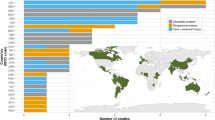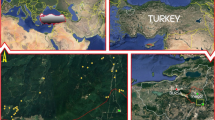Abstract
The effect of vegetation on soil properties (acidity, C/N ratio, content of exchangeable nutrients) was assessed for the northern and middle taiga forests in the Republic of Karelia. The forests occupy autonomous positions in the landscapes; the soil-forming rocks are diverse. The study objects were Al–Fe–humus soils on Quaternary sediments, common for taiga forests. Albic Podzols predominate among them. The differences in the properties of organic soil horizons (corresponding to the taxonomic levels of forest types and formations) within and between the taiga subzones may be explained by variations in the composition of soil-forming rocks and the amount of precipitation, as well as by the influence of vegetation. It is shown that, along with the quality of plant residues produced by the predominant functional groups, the soil properties depend on the regulation by trees of the amount and composition of precipitation penetrating through their crowns and affecting the intensity of nutrients leaching from the soils.





Similar content being viewed by others
REFERENCES
N. A. Artemkina, T. T. Gorbacheva, and N. V. Lukina, “Low-molecular-weight organic acids in soil waters of forests of the Kola Peninsula,” Lesovedenie, No. 6, 37–44 (2008).
G. V. Akhmetova, “The content of trace elements in pedogenic minerals and forest soils of lake-glacial plains in the middle taiga subzone of Karelia,” Lesn. Vestn., No. 2, 16–20 (2008).
O. N. Bakhmet, “Specific features of soil organic matter in forest landscapes of Karelia,” Contemp. Probl. Ecol. 5, 654–661 (2012).
O. N. Bakhmet, “Specific soils of the rock landscapes of Karelian coast of the White Sea,” Uch. Zap. Petrozavodsk. Gos. Univ., Estestv. Tekh. Nauki, No. 6 (135), 55–59 (2013).
O. N. Bakhmet and R. M. Morozova, “Soil cover,” in Diversity of Biota of Karelia: Formation, Communities, and Species (Karelian Scientific Center, Russian Academy of Sciences, Petrozavodsk, 2003), pp. 34–37.
O. N. Bakhmet, N. G. Fedorets, and A. M. Kryshen, “Research within the ICP-forests program in Karelia,” Tr. Karel. Nauchn. Tsentra, Ross. Akad. Nauk, No. 2, 133–139 (2011).
I. I. Vasenev and V. O. Targulian, Windfall and Taiga Pedogenesis: Regime, Processes, and Morphogenesis of Soil Successions (Nauka, Moscow, 1995) [in Russian].
Geology of Karelia, Ed. by V. A. Sokolova (Nauka, Leningrad, 1987) [in Russian].
N. I. Kazimirov and R. M. Morozova, Biological Cycle of Substances in Spruce Forests of Karelia (Nauka, Leningrad, 1973) [in Russian].
L. O. Karpachevskii, Forest and Forest Soils (Lesnaya Prom-st’, Moscow, 1981) [in Russian].
I. B. Kucherov and A. A. Zverev, “Lichen pine forests of the middle and northern taiga of European Russia,” Vestn. Tomsk. Gos. Univ., Biol., No. 3 (19), 46–80 (2012).
S. N. Lesovaya, S. V. Goryachkin, A. A. Zavarzin, E. Yu. Pogozhev, and Yu. S. Polekhovskii, “Specificity of boreal pedogenesis and weathering on hard rocks in the Kivach Nature Reserve (Karelia),” Vestn. S.-Peterb. Univ., Ser. 3: Biol., No. 1, 106–118 (2006).
N. V. Lukina, T. T. Gorbacheva, V. V. Nikonov, and M. A. Lukina, “Spatial variability of soil acidity in Al- Fe-humus podzols of northern taiga,” Eurasian Soil Sci. 35, 144–155 (2002).
N. V. Lukina, M. A. Orlova, and L. G. Isaeva, “Forest soil fertility: the base of relationships between soil and vegetation,” Contemp. Probl. Ecol. 4, 725–733 (2011).
N. V. Lukina, L. M. Polyanskaya, and M. A. Orlova, Nutritional Regime of Soil in Northern Taiga Forests (Nauka, Moscow, 2008) [in Russian].
K. N. Manakov and V. V. Nikonov, Biological Cycle of Mineral Elements and Soil Formation in Spruce Forests of the Extreme North (Nauka, Leningrad, 1981) [in Russian].
Monitoring of Forests According to the International Program ICPForests (Russian Forest Protection Center, Moscow, 2008) [in Russian].
R. M. Morozova, “Geographical pattern of the development of soil cover in Karelia,” in Biogeography of Karelia, Tr. Karel. Nauchn. Tsentra, Ross. Akad. Nauk, Biol. (Petrozavodsk, 2001), No. 2, pp. 12–18.
V. V. Nikonov and N. V. Lukina, “Influence of spruce and pine on the acidity and composition of atmospheric fallout in north taiga forests of an industrially developed region,” Russ. J. Ecol. 31, 82–89 (2000).
V. V. Nikonov, N. V. Lukina, L. M. Polyanskaya, and A. N. Panikova, “Distribution of microorganisms in the Al–Fe-humus podzols of natural and anthropogenically impacted boreal spruce forests,” Microbiology (Moscow) 70, 319–328 (2001).
M. A. Orlova, N. V. Lukina, V. E. Smirnov, and N. A. Artemkina, “The influence of spruce on acidity and nutrient content in soils of Northern Taiga dwarf shrub–green moss spruce forests,” Eurasian Soil Sci. 49, 1276–1287 (2016).
M. A. Orlova, N. V. Lukina, V. E. Smirnov, and L. G. Isaeva, “Soil fertility in birch forests at the northern margin of the range,” Pochvovedenie, No. 3, 1–13 (2014).
M. A. Orlova, N. V. Lukina, V. E. Smirnov, D. A. Krasnov, and I. O. Kamaev, “Fertility of soils under spruce forests of the Khibiny Mountains,” Eurasian Soil Sci. 45, 612–624 (2012).
Diversity of Biota of Karelia: Formation Conditions, Communities, and Species, Ed. by A. N. Gromtsev, S. P. Kitaev, V. I. Krutov, O. L. Kuznetsov, T. Lindkhol’m, and E. B. Yakovlev (Karelian Scientific Center, Russian Academy of Sciences, Petrozavodsk, 2003) [in Russian].
N. P. Remezov, “Role of forest in soil formation,” Pochvovedenie, No. 4, 70–79 (1956).
G. P. Urbanavichyus and I. N. Urbanavichene, “Lichen of Russian nature reserves,” in Modern Biological Diversity in Russian Nature Reserves, No. 3: Lichen and Mosses (Grif i K, Moscow, 2004), pp. 5–243.
N. G. Fedorets, R. M. Morozova, and A. N. Solodovnikov, “Forest soils of Karelia and their productivity assessment,” Tr. Karel. Nauchn. Tsentra, Ross. Akad. Nauk, No. 5, 108–120 (2003).
O. A. Fomicheva, L. M. Polyanskaya, V. V. Nikonov, N. V. Lukina, M. A. Orlova, L. G. Isaeva, and D. G. Zvyagintsev, “Population and biomass of soil microorganisms in old-growth primary spruce forests in the northern taiga,” Eurasian Soil Sci. 39, 1323–1331 (2006).
S. K. Cherepanov, Vascular Plants of Russia and Neighboring Countries (Mir i Sem’ya, St. Petersburg, 1995) [in Russian].
D. Binkley and C. Giardina, “Why do tree species affect soil? The warp and woof of tree-soil interaction,” Biogeochemistry 42, 89–106 (1998).
J. H. C. Cornelissen, et al., “Global negative vegetation feedback to climate warming responses of leaf litter decomposition rates in cold biomes,” Ecol. Lett. 10 (7), 619–627 (2007).
J. H. C. Cornelissen and K. Thompson, “Functional leaf attributes predict litter decomposition rate in herbaceous plants,” New Phytol. 135 (1), 109–114 (1997).
V. V. Ershov, N. V. Lukina, M. A. Orlova, and N. V. Zukert, “Dynamics of snowmelt water composition in conifer forests exposed to air-born industrial pollution,” Russ. J. Ecol. 47 (1), 46–52 (2016).
Forest Condition in Europe: 2011 Technical Report of ICP Forests and FutMon: Work Report of the Institute for World Forestry (ICP Forests, Hamburg, 2011).
K. Hansson, B. A. Olsson, M. Olsson, U. Johansson, and D. B. Kleja, “Differences in soil properties in adjacent stands of Scots pine, Norway spruce and silver birch in Sweden,” Forest Ecol. Manage. 262 (3), 522–530 (2011).
F. Husson, S. Lê, and J. Pagès, Exploratory Multivariate Analysis by Example Using R, 2nd ed. (CRC Press, Boca Raton, 2017).
M. S. Ignatov, O. M. Afonina, E. A. Ignatova, A. Abolina, T. V. Akatova, E. Z. Baisheva, L. V. Bardunov, E. A. Baryakina, O. A. Belkina, A. G. Bezgodov, Ya. Boychuk, V. M. A. Cherdantseva, I. V. Czernyadjeva, G. Ya. Doroshina, A. P. Dyachenko, et al., “Check list of mosses of East Europe and North Asia,” Arctoa 16, 1–130 (2006).
T. Ingestad, “Mineral nutrient requirements of Vaccinium vitis idaea and V. myrtillus,” Physiol. Plant. 29 (2), 239–246 (1973).
N. A. Konstantinova, V. A. Bakalin, E. N. Andrejeva, A. G. Bezgodov, E. A. Borovichev, M. V. Dulin, and Yu. S. Mamontov, “Checklist of liverworts (Marchantiophyta) of Russia,” Arctoa 18, 1–63 (2009).
N. V. Lukina, M. A. Orlova, A. V. Gornov, A. M. Kryshen’, P. V. Kuznetsov, S. V. Knyazeva, V. E. Smirnov, O. N. Bakhmet, S. P. Eydlina, V. V. Ershov, N. V. Zukert, and L. G. Isaeva, “Assessment of sustainable forest management criteria using indicators of the international program ICP forests,” Contemp. Probl. Ecol. 6 (7), 734–745 (2013).
T. Murakami, S. Utsunomiya, T. Yokoyama, and T. Kasama, “Biotite dissolution processes and mechanisms in the laboratory and in nature: early stage weathering environment and vermiculitization,” Am. Miner. 88, 377–386 (2003.
T. Ohta and T. Hiura, “Erratum: Root exudation of low-molecular-mass-organic acids by six tree species alters the dynamics of calcium and magnesium in soil,” Can. J. Soil Sci. 96 (4), 516–516 (2016).
R Core Team, R: A Language and Environment for Statistical Computing (R Foundation for Statistical Computing, Vienna, 2017). http://www.R-project.org.
M. Salemaa, J. Derome, and P. Nöjd, “Response of boreal forest vegetation to the fertility status of the organic layer along a climatic gradient,” Boreal Environ. Res. 13, 48–66 (2008).
E. Steinnes, N. Lukina, V. Nikonov, D. Aamlid, and O. Royset, “A gradient study of 34 elements in the vicinity of a copper-nickel smelter in the Kola Peninsula,” Environ. Monit. Assess. 60 (1), 71–88 (2000).
ACKNOWLEDGMENTS
The information was collected according to the state assignment of the Center for Forest Ecology and Productivity, Russian Academy of Sciences “Preservation and Restoration of Ecological Functions of Forest Soils” (project no. 0110-2014-0004) and the Program of the Presidium of the Russian Academy of Sciences “Biodiversity of Natural Systems”, project “Forest-forming Species of Russia: Spatial Distribution, Reserves, Contribution to Ecosystem Functions and Services"(project no. 0110-2015-0005). The chemical analyses of soils were performed under support of the Russian Foundation for Basic Research (project no. 15-29-02697 ofi_m). The processing of the data was supported by the Russian Science Foundation (project no. 16-17-10284).
Author information
Authors and Affiliations
Corresponding author
Additional information
Translated by L. Kholopova
Rights and permissions
About this article
Cite this article
Lukina, N.V., Orlova, M.A., Bakhmet, O.N. et al. The Influence of Vegetation on the Forest Soil Properties in the Republic of Karelia. Eurasian Soil Sc. 52, 793–807 (2019). https://doi.org/10.1134/S1064229319050077
Received:
Revised:
Accepted:
Published:
Issue Date:
DOI: https://doi.org/10.1134/S1064229319050077




